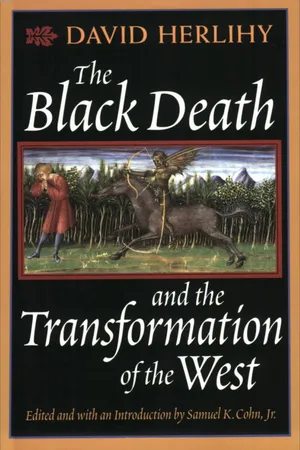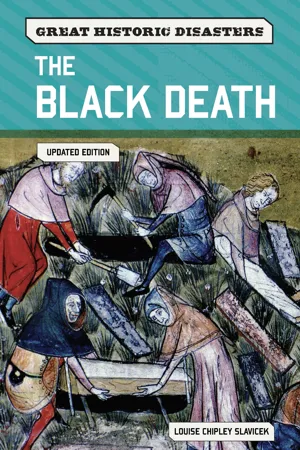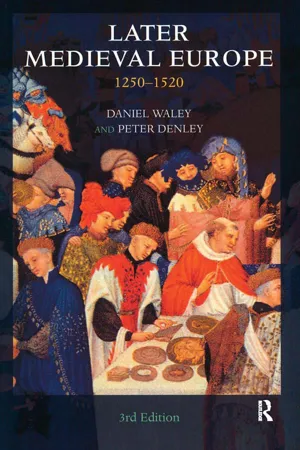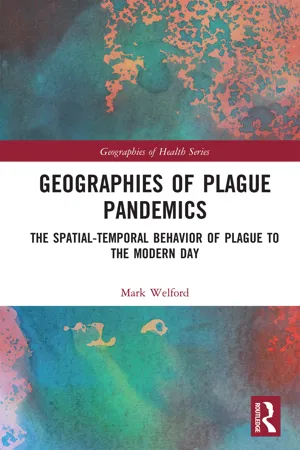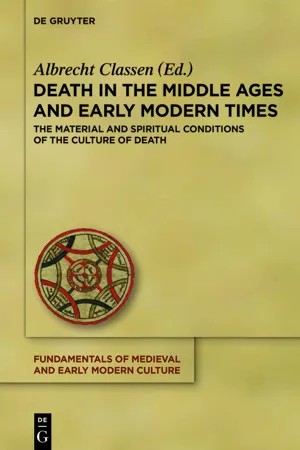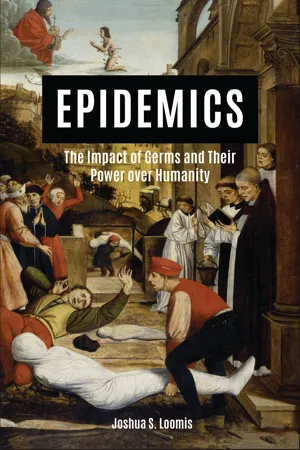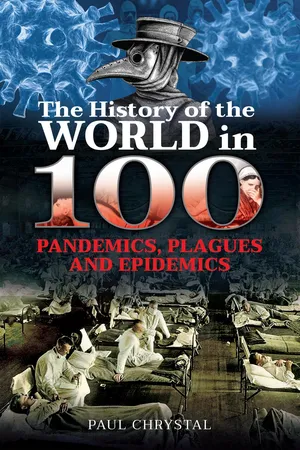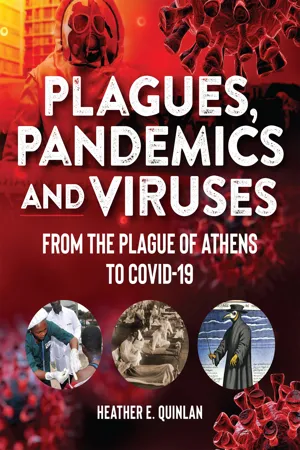History
The Black Death
The Black Death was a devastating pandemic that swept through Europe in the 14th century, resulting in the deaths of an estimated 25 million people, or about one-third of the continent's population. The disease, most likely bubonic plague, spread rapidly through fleas infesting rats and was transmitted to humans through bites. The Black Death had profound social, economic, and cultural impacts on Europe.
Written by Perlego with AI-assistance
Related key terms
Related key terms
1 of 4
Related key terms
1 of 3
12 Key excerpts on "The Black Death"
- David Herlihy, Samuel K. Cohn Jr.(Authors)
- 1997(Publication Date)
- Harvard University Press(Publisher)
ONEBubonic Plague: Historical Epidemiology and the Medical Problems
The Black Death of 1348 and 1349, and the recurrent epidemics of the fourteenth and fifteenth centuries, were the most devastating natural disasters ever to strike Europe.1 We cannot cite exact losses; there are no global figures. The populations of some cities and villages, in areas as far removed from each other as England and Italy, fell in the late decades of the fourteenth century by 70 or 80 percent.2 The more we learn of the late medieval collapse in human numbers, the more awesome it appears. Europe about 1420 could have counted barely more than a third of the people it contained one hundred years before.This was Europe’s greatest known ecological disaster, and also the last of such magnitude it has had to endure. The epidemics of modern history seem mild when compared with the fury of The Black Death. A principal thesis here is that the two salient characteristics of the population collapse of the late Middle Ages—Europe’s deepest and also its last—are not unrelated. The devastating plagues elicited a social response that protected the European community from comparable disasters until the present.The great medieval epidemics have in recent years attracted considerable attention from historians. There are several reasons for this. In part it reflects the contemporary effort of historians to recapture more of the past than their predecessors accomplished. Ultimately, they would like to reconstruct the entire environment, the total life situation, that prevailed in past epochs. In this quest for total history, they of course include the cultural climate—ideas, ideologies, beliefs, myths and values—that circumscribed human life. But the physical environment also demands consideration. How did human communities interact with their natural surroundings? What were the ecological systems of the past? Indisputably, microorganisms play a crucial role in all systems of human ecology. Parasitic microbes also have a history, dark to be sure, but intimately connected with that of their human hosts.- eBook - ePub
- Irwin W. Sherman(Author)
- 2017(Publication Date)
- ASM Press(Publisher)
4 An Ancient Plague, The Black DeathFigure 4.1 The Plague by Felix Jenewein (1900) shows a mother carrying a coffin with her child (Courtesy Wellcome Library, London, CC-BY 4.0)During the last 2,500 years, three great plague pandemics have resulted in social and economic upheavals unmatched by armed conflicts or any other infectious disease. In Constantinople, the capital of the Roman Empire in the East, it was the first plague pandemic (A.D. 542-543) that surely contributed to Justinian’s failure to restore imperial unity. In the year 1346 the second pandemic began, and by the time it disappeared in 1353, the population of Europe and the Middle East had been reduced from 100 million to 80 million people (Fig. 4.1 ). This devastating pandemic, known as The Black Death, the Great Dying, or the Great Pestilence, put an end to the rise in the human population that had begun in 5000 B.C., and it took more than 150 years for the population to return to its former size. Some believe this catastrophic crash in population to be Malthus’s prophecy come true, while others, such as the historian David Herlihy, consider The Black Death to be not a catastrophe promoted by “positive checks” (i.e., disease, war, and famine) but an exogenous factor that served to break a Malthusian stalemate. That is, despite fluctuations in population size, relatively stable population levels were maintained over prolonged periods of time due to “preventive checks” (i.e., changes in inheritance practices, delay in the age of marriage, and birth controls). The Black Death did more than break the Malthusian stalemate; it allowed Europeans to restructure their society along very different paths.Although those living in the medieval period recognized that plague was a contagious disease spread from person to person, its cause was not identified. Indeed, most believed it to be “a vicious property of the air” itself. The Black Death is most associated with Florence, one of the great cities of Europe at the time, and because it felt the full impact of the epidemic, it is sometimes called the Plague of Florence. Giovanni Boccaccio (1313-1375), who lived in Florence during the plague, described what he witnessed: - eBook - ePub
- Louise Slavicek(Author)
- 2021(Publication Date)
- Chelsea House(Publisher)
Chapters
Passage contains an image
Introduction: "Life Is But One Long Agony"
In 1346, Europe was hit by the worst natural disaster in its recorded history: The Black Death. Generally believed to be a combination of bubonic plague and two other plague strains, The Black Death ravaged the length and breadth of Europe from Sicily to Norway, from Ireland to Russia, for five terrible years. Scholars can only speculate regarding how many people perished in the lethal pandemic, which also swept across parts of western Asia and North Africa during the late 1340s and early 1350s. Most historians, however, agree that The Black Death killed anywhere from 33 to 60 percent of Europe's total population—roughly 25 million to 45 million men, women, and children. (A pandemic is a disease outbreak that affects a large geographical area and a high percentage of the population.)The Great Mortality and The Black Death
During the Middle Ages (about 400 to 1400), the notorious pandemic of the mid-1300s was usually referred to as the Great Mortality or, simply, the pestilence (meaning a deadly contagious disease). The term Black Death did not come into general use until centuries after the outbreak. To date, just one writing from the medieval era has been found that mentions the phrase—a Latin poem about the pandemic that scholars now believe may have been mistranslated.In the poem, author Simon de Covinus, a Flemish (Belgian) astronomer, labels the pandemic as the "mors atra." Later European translators of de Covinus's poem, and of several sixteenth-century Swedish and Danish chronicles that use the same term, took the phrase to mean "The Black Death," even though the word atra signifies both "terrible" and "black" in Latin. The translators may have chosen "black" rather than "terrible" as the more likely of the two meanings because they were under the common misconception that the fingers and other extremities of plague victims usually blacken as the disease progresses. In fact, blackening of the extremities from hemorrhaging beneath the skin (heavy bleeding from ruptured blood vessels) only occurs in an extremely rare plague strain known as septicemic plague. Accurate or not, by the early twentieth century the term Black Death - eBook - ePub
Later Medieval Europe
1250-1520
- Daniel Waley, Peter Denley(Authors)
- 2013(Publication Date)
- Routledge(Publisher)
For many, this dramatic and highly visible human catastrophe in the middle of the ‘century of transition’ epitomised the many other ill winds of the period, and perhaps even brought them to a head in what can retrospectively be seen as a sort of ‘defining moment’. This currently fashionable but imprecise phrase has much to recommend it here, as it avoids the implications of causation that have bedevilled the historiography. In many respects historians are less clear about The Black Death than they thought they were thirty years ago. For example, even the nature of the disease itself has been called into question. 19 What is striking, however, is the persistence of the belief that, because it was such a dramatic event, it must have had a profound effect. 20 This has become an idée fixe, perhaps a consequence of the profession's vested interest in identifying clear causes of change. Historians have found in The Black Death seductively simple explanations for developments as diverse (and contradictory) as the economic crisis under discussion here, the explosion of popular unrest, the undermining of authority and the birth of a lay spirit, the transformation of religious devotion, the revival of higher education, the acceleration of technological innovation, the ‘modernisation’ of medicine and the birth of scientific thought, the increase of state intervention and control and the growth of national sentiment, the formation of the nuclear family and even the rise of the individual. When most of these theories are examined, they tend to collapse under their own crudity; yet, seemingly undeterred, historians have moved rapidly from the discrediting of one theory to set up the next. It is one thing to identify immediate consequences of the demographic impact of plague. 21 It is another matter to evaluate the impact this had on economic balance, as opposed to volume, even in the short term - eBook - ePub
- Robert S. Gottfried(Author)
- 2010(Publication Date)
- Free Press(Publisher)
CHAPTER 7
Disease and theTransformation ofMedieval Europe
I F The Black Death had been the only plague epidemic of the later Middle Ages, its historical importance would be diminished. It would be remembered as a severe and catastrophic blow, but an isolated one. Human population is very resilient and responds to any single check, even one as severe as The Black Death. By 1360, population levels all across Europe were beginning to creep back toward their preplague levels. Had the high marriage and birth rates and low mortality rates of the 1350s continued unabated, the demographic damage of The Black Death would have been undone by the 1380s, and parts of Europe would once again have been in the throes of a subsistence crisis. By 1361, it appears that many people had forgotten The Black Death, and some aspects of daily life resumed. The changes in psyche and, consequently, in styles and modes of art probably would have remained, and the trifunctional system would still have been profoundly shaken. But many of the other social and most of the economic changes were just beginning and might have been nipped in the bud. This was not to happen.In the spring of 1361 the pestis secundo , the second epidemic of the second plague pandemic, broke out in Europe. Plague was the only agent that could assure continuing high mortality. In Malthusian terms, it was the most severe “positive check” possible, and the only one which could keep mortality high enough to avert a renewal of the subsistence crisis that had impoverished Europe from the middle of the thirteenth century. Plague would recur every few years for the rest of the fourteenth and all of the fifteenth century, and initiate an era of depopulation that would last until the sixteenth century. From such depopulation would come changes even more profound than those brought by The Black Death.1 - eBook - ePub
Edward the Black Prince
A Study of Power in Medieval Europe
- David Green(Author)
- 2023(Publication Date)
- Routledge(Publisher)
2 The Black DeathDOI: 10.4324/9781003280934-3It [the plague] left hardly enough people alive to give the dead a decent burial…Ulcers broke out in the groin and the armpit, which tortured the dying for three days…And there was in those days death without sorrow, marriage without affection, self-imposed penance, want without poverty and flight without escape…In the end the plague devoured a multitude of people…Scarcely a tenth of the population survived.1John of Reading’s account is something of an exaggeration; it was probably a mere third and almost certainly no more than a half of the population of England that died during the plague of 1348–50. It has been ranked, if such events can really be assessed in this way, as the second worst catastrophe in history, falling only behind the Second World War in its appalling consequences.2Although it has long been suggested that The Black Death was bubonic plague, possibly with pneumonic or septicaemic variants encouraging the great speed of transmission, attempts have been made to explain certain aspects of the pandemic by offering alternative diagnoses.3 However, recent scientific analyses have proved conclusively that the plague which devastated Europe and beyond in the fourteenth century was, indeed, caused by the bacterium Yersinia pestis and that fleas carried by rodents, chiefly rats, provided the main means of transmission. Such work has also contributed a great deal to our understanding of the plague’s origins, in central Asia, and the route by which it entered Europe.4But, even if we have learned much about the nature of the plague and its spread within and beyond Europe, attempts to quantify its precise impact must remain somewhat speculative. There is, though, little doubt that the plague contributed enormously to the changing character of the continent and the ways by which power was wielded within it. Economic and social relations, agricultural practices, and land use were all affected by The Black Death. The plague also altered the way individuals conceived of their place in the world, in relation to their neighbours and their social ‘superiors’, both secular and ecclesiastic. Since, for the majority, the only conceivable explanation for the plague was that it manifested God’s wrath with a sinful people, the huge levels of mortality changed perspectives regarding the divine and His Church. (Because the plague influenced so many aspects of later medieval society, reference to it will be made throughout the remainder of this book. In particular, some of the religious implications of the pandemic are examined in Chapter Six - eBook - ePub
Geographies of Plague Pandemics
The Spatial-Temporal Behavior of Plague to the Modern Day
- Mark Welford(Author)
- 2018(Publication Date)
- Routledge(Publisher)
DeWitte 2015 ).The medieval Black Death was also one of the first truly global pandemics, uniting east and west, a harbinger of things to come, such as the Spanish flu epidemic of 1918–19 and AIDS. Possibly originating in China in the 1330s (Bos et al. 2016;Schmid et al. 2015), it moved along caravan trading routes across Central Asia, once known to Marco Polo, before arriving with the Golden Horde at the gates of Caffa (Varlik 2008 ). To reiterate: in a geographical sense, the medieval Black Death marked the beginning of a smaller, more highly connected, spatially integrated world where ideas, goods, and diseases could be rapidly transported to all corners of the globe. At the same time, Europe was transitioning from a 38 serf-dominated, rural society to an early interdependent, market-based capitalist economy that connected towns and ports through transportation of goods and services. Yet as this economic transition was in full swing, medical knowledge remained mired in Hippocrates’ and Galen’s understanding of disease. Thus doctors of the time had a very limited ability to adopt any useful means to counter epidemics (Benedictow 2004 , 2005 ). To repeat, a small world selects for pandemics and greater viral and bacterial virulence (Boots and Sasaki 1999 ; Bossak and Welford 2010 ). In a large world with extensive distances between human groups or clusters, low transmission rates and low virulence ensure that diseases neither infect nor kill all humans in a group or cluster, ensuring that the disease does not become extinct (Boots and Sasaki 1999 ). In a small world, one that is highly connected and where travel times between human groups or clusters are short, these local thresholds break down. As a result, highly virulent diseases can jump between clusters before local extinctions occur (Boots and Sasaki 1999 ). It would appear that in the 1340s, Europe and Central Asia reached some threshold of critical connectivity among human clusters (Boots and Sasaki 1999 ). This critical connectivity ultimately killed as many as 50 million people or 60% of Europe’s population (Benedictow 2005 ) and millions in Central Asia, when the plague underwent a cross-species transmission from marmots to humans (Bos et al. 2016;Schmid et al. 2015;Stenseth et al. 2006;Wilschut et al. - eBook - ePub
AIDS, Fear and Society
Challenging the Dreaded Disease
- Kenneth J. Doka(Author)
- 2014(Publication Date)
- Routledge(Publisher)
Again, in the absence of a credible science, the plague, at that point called “The Black Death,” was blamed on divine retribution. The disease was perceived as punishment, perhaps for sexual indiscretions or tolerating heresy. A call for a pilgrimage to Rome in 1348 by Pope Clement VI brought more than a million people to Rome, carrying disease as they traveled. Flagellants, religious devotees who whipped themselves for atonement, also marched in processions from town to town, bringing the disease with them. Other forms of obsessiveness, a dancing mania and a widespread cult of the dead, were also common. The disease also caused widespread persecution, most particularly of the Jews but also cripples and lepers. In fact Boswell (1980), in a history of homosexuality, considered the 12th century a tolerant one. Monarchs openly engaged in gay love affairs. Yet there was far less tolerance in the 13th and 14th centuries. There were a number of reasons for this, Boswell believes. The Crusades had heightened religious feelings. The development of nation states and absolute monarchies fed pressures for conformity. But the plague also played a role, buttressing a sense of divine retribution that made all minorities—Jews, lepers, cripples, heretics, and homosexuals—suspect.The Black Death was an epochal event. Hourani (1991) viewed the plague as a significant factor in Islamic society, depopulating cities and reducing its agricultural base so that it was less prepared for Christian counterattacks that allowed the reconquest of Spain and Ottoman capture of the Islamic world. Others have debated its effects on the West. Some have seen The Black Death as contributing to an emergent individualism (Aires, 1987) and a decline of feudalism (Claster, 1982). It may have unwittingly set the stage for the Reformation, providing Catholicism with a serene judgmental theology that Luther, over a century later, would attack. In any case, it decimated the intellectual classes, particularly those in medicine and the clergy, who were on the caregiving forefront of the epidemic, and turned the philosophical optimism of the 13th century to a deepening sense of doom (A. M. Campbell, 1966).Most historians believe that The Black Death was a bubonic plague, particularly its more virulent pneumonic form. In this disease, massive internal hemorrhaging caused a black discoloration that may have given the disease its name.1 - eBook - ePub
- Albrecht Classen, Albrecht Classen, Albrecht Classen(Authors)
- 2016(Publication Date)
- De Gruyter(Publisher)
407 and general historians depict the past pandemic of a culture turned morbid. Scholars now consider what happened and how the populace responded. Many fine studies have acknowledged various ramifications of this catastrophic Black Death throughout Europe after 1350. As Aron Ja. Gurevich indicates:A decrease in economic activity and the colossal population decline that followed the Great Plague of 1348–49 (which was understood by contemporaries as a manifestation of divine wrath for the sins of humankind) prompted a serious psychological, social, and moral crisis that struck the merchant along with the rest of society. Death became a close acquaintance and a permanent threat.408The persistent and overwhelming prevalence of death generated powerful religious, literary, and artistic images of skeletal figures, rotting corpses, and vividly emotional Passion scenes of Jesus Christ. Modern writers have been stirred by the fascinating evolution brought about by this intriguing epidemic. John Henderson409 has written about Florence, Milton Meiss410 about art in Florence and Siena, Ormrod and Lindley411 about England, Samuel Cohn412 about Italy, Graham Caie413 about opposing cultures in England, Bowsky414 about Siena, and others about Europe in general. However, the numerous cultural and artistic consequences of such extensive devastation on religious thinking, literary production, and artistic creation have yet to be fully categorized and compared.Preceding famines may have diminished the English population of six million (see Cantor’s In the Wake of the Plague 415 ; John Hatcher’s Plague, Population, and The English Economy 416 ; Hilton’s Bondsmen Made Free 417 ; and Binski’s Medieval Death 418 ), but The Black Death utterly crushed the citizenry. During their century-long struggle back, victims found multiple methods of coping with the shocking loss of family, friends, and neighbors. Their communities had dissolved before their eyes. As Gordon Home observes,After ten years, a third of the walled area [of London] was void of inhabitants. The main effect of this fearful visitation was to dislocate the economic structure of the kingdom. Labour became scarce, and the working man’s services were so valuable that he could extract higher wages …. Further, there was a tendency to migrate from one place to another.419 - eBook - ePub
Epidemics
The Impact of Germs and Their Power over Humanity
- Joshua S. Loomis(Author)
- 2018(Publication Date)
- Praeger(Publisher)
Once in a new location, rats would jump off the ships, mate with local rats, and transmit the disease to a new population. It is believed to have spread very rapidly between humans through the inhalation of infected respiratory secretions (pneumonic plague) until there were no hosts left to infect. The devastating social impact that such enormous amounts death had on the people is best described by Giovanni Boccaccio, who in the Decameron (1353), wrote, “Citizen avoided citizen, kinsfolk held aloof, or never met or but rarely; in the horror thereof brother was forsaken by brother, nephew by uncle, brother by sister, and oftentimes husband by wife; may, what is more and scarce to be believed, fathers and mothers were found to abandon their own children, untended, unvisited, to their fate, as if they had been strangers.” 12 Much as it did 800 years previously, The Black Death produced deleterious effects on all facets of life, forever changing the way people lived, thought, and interacted with one another. Most historical analyses of the 14th-century Black Death primarily focus on how it affected Europe despite the likelihood that it killed millions in Asia before ever moving westward. Interestingly, there are very few documented accounts of plague activity in Chinese texts from the 14th century and even fewer from Indian sources. Some Chinese medical documents from that time period (the Song-Yuan Dynasty) describe a disease that had characteristic swollen lymph nodes and high fevers and produced a great number of deaths between 1331 and 1353. 13 Also, a census conducted during that time reported that the population of China was nearly cut in half during the second half of the 14th century, with some provinces reporting losses of almost 90 percent of its inhabitants - Paul Chrystal(Author)
- 2021(Publication Date)
- Pen and Sword History(Publisher)
THE MIDDLE AGES Chapter 8 Bubonic Plague: The Black Death: 1346–1353 (Start of the Second Plague Pandemic) ‘First pray, then flee.’ – From Dr Alonso de Chirino’s practical guide to the plague for the layperson (c. 1431) ‘The year of 1348 has left us alone and helpless. Where are our dear friends now? Where are the beloved faces? Where are the affectionate words? the relaxed and enjoyable conversations?’ – Francesco Petrarca, (b.1304), Petrarch T o the Florentine poet plague was a disease ‘without equal for centuries’; it had ‘trampled and destroyed the entire world’. It may well have all started in India, spreading through Asia, North Africa and then to Europe. Plague probably came to England courtesy of an infected rat or flea at Melcombe Regis (now Weymouth) at the end of July or beginning of August, 1348. It then spread through the south-west to Bristol and then eastwards to Oxford and London, which it had reached by the beginning of November travelling at the rate of about 1½ miles per day. In Europe, it is estimated around 50 million people died as a result of The Black Death, also known as the Great Mortality or the Great Pestilence. The population fell from some 80 million to 30 million. It killed at least 60 per cent of the population in rural and urban settings. It took the world population 200 years to recover to the level at which it stood in the early 1340s. The 1347 pandemic plague was not referred to specifically as ‘black’ in the 14th or 15th centuries in any European language. In fact ‘Black Death’ was not used to describe the plague pandemic in English until 1755, when it translated the Danish: den sorte død, ‘The Black Death’. As is usual, the poor were worst affected: they tended to live in single-storey thatched wattle-and-daub hovels. Rats burrowed under their earth floors and climbed the walls to build their nests in the roofs, from which blocked fleas could fall to infect the residents below- eBook - ePub
Plagues, Pandemics and Viruses
From the Plague of Athens to Covid 19
- Heather E. Quinlan(Author)
- 2020(Publication Date)
- Visible Ink Press(Publisher)
malady .Malady, though indeed an illness, doesn’t come close to describing the horror of The Black Death. Perhaps people didn’t yet have the language for it because nothing this destructive had occurred within living memory; the word “pandemic,” for instance, wasn’t coined until the 1500s (from the Latin word pandēmus , meaning “affecting all”). The name itself was not used during the pandemic; people weren’t screaming, “It’s The Black Death! The Black Death!” Some called it “the Great Mortality,” “the Great Pestilence,” or even the “the Blue Death” due to the color of many of the corpses, but the term “Black Death” wasn’t used until the eighteenth century, and even then, it was to identify this plague as a kind of death to end all deaths—while several plagues were still to come in subsequent centuries, none would cause as much devastation as this one.Bubonic plague was part of the worst pandemic in history, killing anywhere from 75 to 200 million people in Europe and Eurasia between 1346 and 1353. That’s equal to between 30 to 60 percent of Europe’s population. It killed so many that it took more than two centuries for the world’s population to recover.WHERE IT BEGAN
T he Black Death boarded ships sailing from ports in Asia, along the trade routes through the Middle East and Turkey, and finally making landfall in Messina, Sicily. Though it was common to personify disease as the Devil or some creature in order to make sense of it, The Black Death had more to do with fleas.Fleas were a common nuisance in medieval Europe. Whether cottages or castles, homes were often plagued with rat, mice, and flea infestations. Add to that the filthy conditions of towns and villages, where human and animal waste were flung in equal parts onto garbage-strewn streets, and you have the potential for any number of illnesses.
Index pages curate the most relevant extracts from our library of academic textbooks. They’ve been created using an in-house natural language model (NLM), each adding context and meaning to key research topics.
Explore more topic indexes
Explore more topic indexes
1 of 6
Explore more topic indexes
1 of 4
